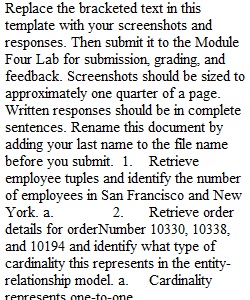


Q Overview It is important to continuously review information because it changes so quickly. Data analysts and scientists must be able to add or delete records because of the changing nature of information. People benefit from working with data by seeing relationships that exist between different entities. For example, manufacturers might want to identify why their equipment came back, where it came from, how long customers took to return it, or many other factors. Directions In this lab, you’ll be using an existing database that is preloaded into Codio from MySQLTutorial.org. You’ll need to compare records from different locations, identify cardinality, delete records, and reflect on the value of these skills. You’ll also need to explain how cardinality can be applied and what its benefits are. All your screenshots and written responses must be placed in the Cardinality and Targeted Data Template from the What to Submit section. Reference MySQLTutorial. (n.d.). MySQL sample database classicmodels [Data file]. MySQLTutorial. https://www.mysqltutorial.org/mysql-sample-database.aspx Before you begin, load the “classicmodels” data set: Reading: Import CSV File Into MySQL Table This resource discusses the process of creating a table with the necessary data types, fields, and their lengths so that information can be imported for querying. As you read, consider the following: • o How do you properly size a VARCHAR? o How do you identify all of the column types that need to be in the table? • Start a terminal session and run this command: mysql < mysqlsampledatabase.sql • Type mysql in the command line and begin working with SQL the way you’ve been in previous labs. • Write commands to use the classicmodels database and show its tables to verify that you’re in the right place. 1. Retrieve employee tuples and identify the number of employees in San Francisco and New York. A. Command for San Francisco: select firstName, lastName, jobTitle, offices.city from employees inner join offices on employees.officeCode = offices.officeCode where state = 'CA'. B. Write and run a command to return records from New York on your own. C. Validate the completion of this step with a screenshot of these two tables. 2. Retrieve order details for orderNumber 10330, 10338, and 10194 and identify what type of cardinality this represents in the entity relationship model. A. Retrieve the order details by running SELECT queries with WHERE clauses against the orders table. B. Validate the completion of this step with a screenshot. C. Then, reference the Module Four Lab ERD to assist in identifying relationships. A version with alternative text is available: Module Four Lab ERD With Alternative Text. D. Now, identify what type of cardinality this represents in the entity relationship model. 3. Delete records from the payments table where the customer number equals 103. A. Run a DESCRIBE statement to identify fields in the payments table first. B. Select the records from the payments table for customer number 103 before deleting them. i. Validate that the above instructions have worked with a screenshot. C. Delete the records from the payments table for customer number 103. D. Run a SELECT statement against the table to show that customer number 103 is no longer there. i. Validate the completion of this step with a screenshot. 4. Retrieve customer records for sales representative Barry Jones and identify if the relationships are one-to-one or one-to-many. A. Remember: SELECT, FROM, Inner Join, and WHERE. B. Use Barry’s employeeNumber, 1504, and perform a join between the customer salesRepEmployeeNumber to retrieve these records. i. Validate the completion of this step with a screenshot. ii. Identify whether these entities demonstrate one-to-one or one-to-many relationships. 5. Retrieve records for customers who reside in Massachusetts and identify their sales rep and the relationship of entities. A. Remember: SELECT, FROM, Inner Join, and WHERE. B. Use employee.firstName and employee.lastName in your command. C. Identify whether these entities demonstrate one-to-one or many-to-many relationships. 6. Add one customer record with your last name using an INSERT statement. A. You may use the name of a celebrity or fictional character if you don’t use your own name. Think of this as your signature. B. Complete these actions to get to the right place to enter this information: (1) Show databases, (2) use classicmodels, (3) show tables, (4) describe customers; i. You should now be seeing all of the fields that you’ll need to fill in to complete this step. ii. Reference your Module Two lab or resources on how to populate these fields if you need to. iii. Fields you’ll need to populate: customerNumber, customerName, contactLastName, contactFirstName, phone, addressLine1, addressLine2, city, state, postalCode, country, salesRepEmployeeNumber, and creditLimit. iv. Run a SELECT statement on the customers table, capture it in a screenshot, and put it in your template. 7. Reflection: Use the lab environment or the screenshots you’ve worked with for this step. Address the following in your reflection: A. Define how cardinality is applied to the databases you’ve been working with and why different numbers of records returned from the different offices. B. Compare and contrast the different queries you ran and how cardinality applies to them. C. Describe two of the crucial benefits of cardinality in this type of database. What to Submit Submit your responses using the Cardinality and Targeted Data Template. Each screenshot and its explanation should be sized to approximately one quarter of the page, with a description written below the screenshot. After you download it, rename your copy of this document by adding your last name to its file name. This will help organize your work once it has been submitted.
View Related Questions